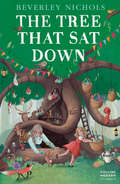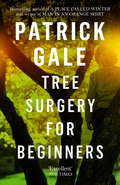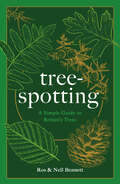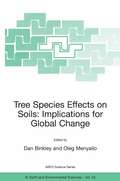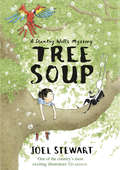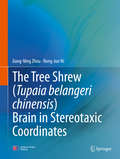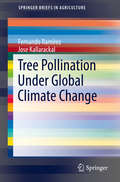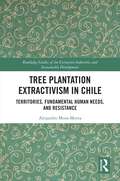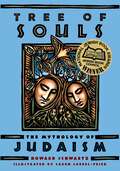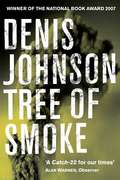- Table View
- List View
Tree Thieves: Crime and Survival in the Woods
by Lyndsie BourgonThe tree was poached in a two-part operation. It was felled one night and taken another.Here was a murder mystery in the deep woods: who had taken the cedar, how had they done so, and - most importantly - why?__________A gripping account of the billion-dollar timber black market -- and how it intersects with environmentalism, class, and culture.In Tree Thieves, Lyndsie Bourgon takes us deep into the underbelly of the illegal timber market. As she traces three timber poaching cases, she introduces us to tree poachers, law enforcement, forensic wood specialists, the enigmatic residents of former logging communities, environmental activists, international timber cartels, and indigenous communities along the way.Old-growth trees are invaluable and irreplaceable for both humans and wildlife, and are the oldest living things on earth. But the morality of tree poaching is not as simple as we might think: stealing trees is a form of deeply rooted protest, and a side effect of environmental preservation and protection that doesn't include communities that have been uprooted or marginalized when park boundaries are drawn. As Bourgon discovers, failing to include working class and rural communities in the preservation of these awe-inducing ecosystems can lead to catastrophic results.Featuring excellent investigative reporting, fascinating characters, logging history, political analysis, and cutting-edge tree science, Tree Thieves takes readers on a thrilling journey into the intrigue, crime, and incredible complexity sheltered under the forest canopy.__________
The Tree that Sat Down (Collins Modern Classics)
by Beverley NicholsCollins Modern Classics are relaunched in gorgeous new covers bringing these timeless story to a new generation.
The Tree That Bleeds: A Uighur Town on the Edge
by Nick HoldstockIn 1997 a small town in a remote part of China was shaken by violent protests that led to the imposition of martial law. Some said it was a peaceful demonstration that was brutally suppressed by the government; others that it was an act of terrorism. When Nick Holdstock arrived in 2001, the town was still bitterly divided. BACK COVER: 'There is still much that is unclear about what actually happened during that violent week in July 2009. But however terrible its cost - whether it was a massacre of peaceful protestors, an orchestrated episode of violence, or something in between - it was not without precedent.' NICK HOLDSTOCK In 1997 a small town in a remote part of China was shaken by violent protests that led to the imposition of martial law. Some said it was a peaceful demonstration that was brutally suppressed by the government; others that it was an act of terrorism. When Nick Holdstock arrived in 2001, the town was still bitterly divided. The main resentment was between the Uighurs (an ethnic minority in the region) and the Han (the ethnic majority in China). While living in Xinjiang, Holdstock was confronted with the political, economic and religious sources of conflict between these different communities, which would later result in the terrible violence of July 2009, when hundreds died in further riots in the region. The Tree that Bleeds is a book about what happens when people stop believing their government will listen.
Tree Surgery for Beginners: A Novel
by Patrick GaleFrom the bestselling author of A PLACE CALLED WINTER, TREE SURGERY FOR BEGINNERS is a funny, elegant and eclectic novel of love, lies and the secrets we live with 'A very funny, often sad, erudite eclectic novel writ with style. Terrific' Time Out'Excellent' The TimesWhen Lawrence Frost wakes up one morning to discover his wife and child have gone missing, there is gruesome evidence to suggest he may be the main suspect in a murder investigation. Confused, threatened with the loss of everything he loves, Lawrence is sent to the Caribbean on a kill-or-cure cruise. On board and ashore he will discover love, deceit, the truth about his missing family, and the blessings that come with surrendering to destiny.
Tree-Structure based Hybrid Computational Intelligence: Theoretical Foundations and Applications (Intelligent Systems Reference Library #2)
by Yuehui Chen Ajith AbrahamResearch in computational intelligence is directed toward building thinking machines and improving our understanding of intelligence. As evident, the ultimate achievement in this field would be to mimic or exceed human cognitive capabilities including reasoning, recognition, creativity, emotions, understanding, learning and so on. In this book, the authors illustrate an hybrid computational intelligence framework and it applications for various problem solving tasks. Based on tree-structure based encoding and the specific function operators, the models can be flexibly constructed and evolved by using simple computational intelligence techniques. The main idea behind this model is the flexible neural tree, which is very adaptive, accurate and efficient. Based on the pre-defined instruction/operator sets, a flexible neural tree model can be created and evolved. This volume comprises of 6 chapters including an introductory chapter giving the fundamental definitions and the last Chapter provides some important research challenges. Academics, scientists as well as engineers engaged in research, development and application of computational intelligence techniques and data mining will find the comprehensive coverage of this book invaluable.
Tree Story: The History of the World Written in Rings
by Valerie TrouetChildren around the world know that to tell how old a tree is, you count its rings. Few people, however, know that research into tree rings has also made amazing contributions to our understanding of Earth's climate history and its influences on human civilization over the past 2,000 years. In her captivating new book, Tree Story, Valerie Trouet reveals how the seemingly simple and relatively familiar concept of counting tree rings has inspired far-reaching scientific breakthroughs that illuminate the complex interactions between nature and people.Trouet, a leading tree-ring scientist, takes us out into the field, from remote African villages to radioactive Russian forests, offering readers an insider's look at tree-ring research, a discipline formally known as dendrochronology. Tracing her own professional journey while exploring dendrochronology's history and applications, Trouet describes the basics of how tell-tale tree cores are collected and dated with ring-by-ring precision, explaining the unexpected and momentous insights we've gained from the resulting samples.Blending popular science, travelogue, and cultural history, Tree Story highlights exciting findings of tree-ring research, including the fate of lost pirate treasure, successful strategies for surviving California wildfire, the secret to Genghis Khan's victories, the connection between Egyptian pharaohs and volcanoes, and even the role of olives in the fall of Rome. These fascinating tales are deftly woven together to show us how dendrochronology sheds light on global climate dynamics and uncovers the clear links between humans and our leafy neighbors. Trouet delights us with her dedication to the tangible appeal of studying trees, a discipline that has taken her to austere and beautiful landscapes around the globe and has enabled scientists to solve long-pondered mysteries of Earth and its human inhabitants.
Tree-spotting: A Simple Guide to Britain's Trees
by Nell Bennett Ros BennettA beautifully illustrated guide to the marvellous and varied world of trees, and a fascinating introduction to the hidden secrets of 52 British species. Botanist and ecologist Ros Bennett has spent a lifetime helping people understand and identify plants and always hoped her daughter Nell would grow up to share her love of the natural world.During Nell's childhood years they spent much time exploring the local woods together. Here, Nell discovered the visual and tactile beauty of trees.In Tree-spotting, Ros and Nell have combined their backgrounds and talents to show you – through Ros's extensive experience and Nell's exquisite illustrations – how to identify 52 British trees simply and confidently.A beautiful and captivating insight into the wonderful world of trees, Tree-spotting burrows down into the history and hidden secrets of each species. It explores how our relationship with trees can be very personal, and will bring you closer to the natural world around you.
Tree Species Effects on Soils: Proceedings of the NATO Advanced Research Workshop on Trees and Soil Interactions, Implications to Global Climate Change, August 2004, Krasnoyarsk, Russia (Nato Science Series: IV: #55)
by Dan Binkley Oleg MenyailoAlmost 50% of the total area of Austria is forested, and the forests are dominated by commercially valuable stands of Norway spruce ( (Picea abies). The few remaining forests that resemble the natural vegetation composition are located in forest reserves with restricted management. These natural forests are used as reference systems for evaluating silvicultural research on sustainable forest management. Natural forests are expected to have high biodiversity, where the structural richness of the habitat enables complex relationships between fauna, flora, and microflora. They also provide refugia for rare plants and animals found only in natural forest types. Austria had 180 of these forest reserves up to the year 2003. Most of these forests are privately owned, and owners are compensated by the government for loss of income associated with conservation status. The Ministerial Conference for the Protection of Forest Ecosystems (MCPFE) has launched a world-wide network of protected forest areas which should cover all major forest types (MCPFE and UNECE/FAO, 2003). The sites selected for our investigation of soil conditions and communities were chosen by vegetation ecologists and soil scientists. The stands have developed under natural competition conditions with no management interventions. All sites were well documented with known forest history. Our set of sites spans gradients of environmental conditions as well as species composition, providing a realistic evaluation of the interactions of biotic and abiotic factors.
Tree Soup: A Stanley Wells Mystery (A\stanley Wells Mystery Ser. #2)
by Joel StewartStanley Wells is an ordinary boy, who happens to be quite curious. His friends are the mysterious Dr Moon and his canine companion Morcambe. Together they seem to stumble upon strange happenings and trip over mysteries that just need solving... Stanley is sleeping in the caravan at the bottom of the garden of his new house. He awakes at the sound of an odd whooooomphing noise and goes to investigate. There appear to be new trees in the garden... very odd. And now his mum and the twins are missing - could these things be connected. And what about Jim, the old man who lives in the woods with his parrot telling tales of the sea? Could he be involved somehow. Dr Moon is the only person who can help Stanley with this puzzle and luckily he's on his way...
The Tree Shrew (Tupaia belangeri chinensis) Brain in Stereotaxic Coordinates
by Jiang-Ning Zhou Rong-Jun NiThis atlas is currently the most systematic and comprehensive atlas of the tree shrew brain. The purpose of this book is to help scientists acquire accurate coordinates of the brain regions of the tree shrew, which is becoming a popular animal model for a variety of human diseases. This atlas contains series of 192 coronal sections, 36 sagittal sections, and 49 horizontal sections using Nissl staining or acetylcholinesterase histochemistry as well as a series of diagrams in stereotaxic coordinates. Original photomicrographs are obtained at single-cell resolution. In addition, we also referred to magnetic resonance images acquired at 250 um intervals with a magnetic resonance scanner 9.4T. Many brain structures are first identified in tree shrews and accurately presented in a stereotaxic coordinate system. The Bregma coordinates system is used for the first time in this tree shrew brain atlas. The atlas represents the collaboration between two indispensable skills of brain research, neuroanatomy and stereotaxic surgery. It will be extensively used in neuroscience research, particularly tree shrew brain study, and will help graduate students and researchers understand brain anatomy and acquire accurate reference coordinates.
Tree-Shaped Fluid Flow and Heat Transfer (SpringerBriefs in Applied Sciences and Technology)
by António F. Miguel Luiz A. RochaThis book provides the first comprehensive state-of-the-art research on tree (dendritic) fluid flow and heat transfer. It covers theory, numerical simulations and applications. It can serve as extra reading for graduate-level courses in engineering and biotechnology. Tree flow networks, also known as dendritic flow networks, are ubiquitous in nature and engineering applications. Tree-shaped design is prevalent when the tendency of the flow (fluid, energy, matter and information) is to move more easily between a volume (or area) and a point, and vice versa. From the geophysical trees to animals and plants, we can observe numerous systems that exhibit tree architectures: river basins and deltas, lungs, circulatory systems, kidneys, vascularized tissues, roots, stems, and leaves, among others. Tree design is also prevalent in man-made flow systems, both in macro- and microfluidic devices. A vast array of tree-shaped design is available and still emerging in chemical engineering, electronics cooling, bioengineering, chemical and bioreactors, lab-on-a-chip systems, and smart materials with volumetric functionalities, such as self-healing and self-cooling. This book also addresses the basic design patterns and solutions for cooling bodies where there is heat generation. Several shapes of fin as well as assemblies of fins are addressed. An up-to-date review of cavities, i.e., inverted or negative fins, for facilitating the flow of heat is also presented. Heat trees using high thermal conductivity material can be used in the cooling of heat-generating bodies, and can also be applied to the cooling of electronics.
Tree Root Systems and Their Mycorrhizas (Developments in Plant and Soil Sciences #7)
by D. Atkinson K. K. S. Bhat M. P. Coutts P. A. Mason D. K. ReadProceedings of a Meeting of the IUFRO, Working Party on Root Physiology and Symbiosis
Tree Rings and Natural Hazards: A State-of-Art (Advances in Global Change Research #41)
by Markus Stoffel Michelle Bollschweiler David R. Butler Brian H. LuckmanDendrogeomorphology Beginnings and Futures: A Personal Reminiscence My early forays into dendrogeomorphology occurred long before I even knew what that word meant. I was working as a young geoscientist in the 1960s and early 1970s on a problem with slope movements and deformed vegetation. At the same time, unknown to me, Jouko Alestalo in Finland was doing something similar. Both of us had seen that trees which produced annual growth rings were reacting to g- morphic processes resulting in changes in their internal and external growth p- terns. Dendroclimatology was an already well established field, but the reactions of trees to other environmental processes were far less well understood in the 1960s. It was Alestalo (1971) who first used the term, dendrogeomorphology. In the early 1970s, I could see that active slope-movement processes were affecting the growth of trees in diverse ways at certain localities. I wanted to learn more about those processes and try to extract a long-term chronology of movement from the highly diverse ring patterns.
Tree Rings: Basics and Applications of Dendrochronology
by Fritz Hans SchweingruberAt a meeting of dendrochronologists an American colleague described the effects of volcanic eruptions on annual ring formation in bristlecone pines. I knew very little about either volcanoes or American pines! At the same meeting European scientists spoke on the dendrochronological dating of lakeshore settlements and the effects of larch bud moth attack on trees in the Alps. It is possible that American participants were not in a position to fully appreciate these papers either. In other words, dendrochronology is an extremely interdisciplinary science; its facets range from modern statistics on wood anatomy to the history of art. It is difficult even for dendrochronol ogists to keep in touch with the whole spectrum, and even more difficult for the layman to obtain an overall view of the many methods and fields of application. In recent times specialisation has begun to hinder communication be tween the various sectors. Archaeologists, for instance, set up their own dendrochronological laboratories and construct independent chronologies to serve their particular interests. The scientific institutions which previously carried out such work are now turning more and more to strongly statistically or biologically-oriented questions. The full wealth of information contained in tree rings, however, will be revealed only when dendrochronologists make a concerted effort to relate the findings of the different fields. In spite of inevitable specialisation, it is necessary that the expert concern himself with the work of his colleagues.
Tree Pollination Under Global Climate Change (SpringerBriefs in Agriculture)
by Fernando Ramírez Jose KallarackalThis brief reviews the pollination aspects of both wild and domesticated fruit tree species in a global climate change context. It explores cross-pollination mediated by insects, vertebrates and abiotic factors, self-pollination and their global warming implications. The authors identify the link between abiotic factors such as precipitation and severe droughts in the context of tree pollination and climate change. Furthermore, pollination and conservation implications in agriculture as well as wild tree populations are explored. Emphasis has been given to fruit trees growing in tropical, subtropical and temperate environments.
Tree Plantation Extractivism in Chile: Territories, Fundamental Human Needs, and Resistance (Routledge Studies of the Extractive Industries and Sustainable Development)
by Alejandro Mora-MottaThis book examines how extractivism transforms territories and affects the well-being of rural people, drawing on in-depth fieldwork conducted on tree plantations in Chile.The book argues that pine and eucalyptus monoculture plantations in southern Chile are a form of extractivism representing a mode of nature appropriation that captures large amounts of natural resources to produce wooden-based raw materials with little processing and an export-oriented focus. The book discusses the nexus of extractivism, territorial transformations, well-being, and emerging resistances using a participatory action research methodological approach in the Region of Los Ríos, southern Chile. The findings show how the configuration of an extractivist logging enclave generated a substantial and irrevocable reordering of human-nature relations, resulting in the territorial and ontological occupation of rural places that disrupted the fundamental human needs of peasants and indigenous people. The book maintains that Chile's green growth development approach does not challenge the consolidated tree plantation enclave controlled by large multinationals. Instead, green growth legitimises the extractivist logic. The book draws parallels with other countries and regions to contribute to wider debates surrounding these topics.This book will be of great interest to students and scholars of the extractive industries, development studies, political ecology, and natural resource governance.
Tree Plantation Extractivism in Chile: Territories, Fundamental Human Needs, and Resistance (Routledge Studies of the Extractive Industries and Sustainable Development)
by Alejandro Mora-MottaThis book examines how extractivism transforms territories and affects the well-being of rural people, drawing on in-depth fieldwork conducted on tree plantations in Chile.The book argues that pine and eucalyptus monoculture plantations in southern Chile are a form of extractivism representing a mode of nature appropriation that captures large amounts of natural resources to produce wooden-based raw materials with little processing and an export-oriented focus. The book discusses the nexus of extractivism, territorial transformations, well-being, and emerging resistances using a participatory action research methodological approach in the Region of Los Ríos, southern Chile. The findings show how the configuration of an extractivist logging enclave generated a substantial and irrevocable reordering of human-nature relations, resulting in the territorial and ontological occupation of rural places that disrupted the fundamental human needs of peasants and indigenous people. The book maintains that Chile's green growth development approach does not challenge the consolidated tree plantation enclave controlled by large multinationals. Instead, green growth legitimises the extractivist logic. The book draws parallels with other countries and regions to contribute to wider debates surrounding these topics.This book will be of great interest to students and scholars of the extractive industries, development studies, political ecology, and natural resource governance.
The Tree of the Toraja (MacLehose Press Editions)
by Philippe ClaudelA middle-aged filmmaker visits Indonesia and becomes entranced by the Toraja custom of interning the bodies of very young deceased children in the trunks of trees. In time, the trunk heals, encasing and protecting the tiny bodies as the tree grows slowly heavenwards. On his return to France, the filmmaker receives news that his dearest friend is dying of cancer, prompting a reflection on the part death occupies in our existence, our inability to confront our mortality and our struggle to conceive of a happy life after a devastating loss.For the Toraja, dying is a central part of being alive. Death is at the forefront of their culture, unlike the western preference for keeping death firmly in the shadows, unacknowledged until it begins to really breathe down your neck and simply cannot be ignored; a taboo subject to be feared and resented. Like the trees of the Toraja, this powerful novel encloses and preserves memories of lost loves and friendships, and contains the promise of rebirth and rebuilding, even after a terrible tragedy.
The Tree of the Sun
by Wilson HarrisThe Tree of the Sun, first published in 1978, begins where Wilson Harris's previous novel Da Silva da Silva's Cultivated Wilderness ended, and thus forms a sequel.The London-dwelling Brazilian painter Da Silva is deeply moved by his wife's pregnancy after eight years of marriage. As he contemplates the child to be born he recalls a painting he began on the very morning he and his wife made love and conception occurred: a painting that contained a growing image. This becomes the evolving 'foetus' of imagination through which Da Silva begins to relate himself and his wife to the former (childless) tenants of their Kensington flat. 'I must admire the imagination and force of Wilson Harris' writing.' Kevin Cully, Tribune
Tree of strings: Crann nan teud: a history of the harp in Scotland (Routledge Library Editions: Folk Music)
by Keith Sanger Alison KinnairdThis is the first history of the harp in Scotland to be published. It sets out to trace the development of the instrument from its earliest appearance on the Pictish stones of the 8th century, to the present day. Describing the different harps played in the Highlands and the Lowlands of Scotland, the authors examine the literary and physical evidence for their use within the Royal Courts and "big houses" by professional harpers and aristocratic amateurs. They vividly follow the decline of the wire-strung clarsach from its links with the hereditary bards of the Highland chieftains to its disappearance in the 18th century, and the subsequent attempts at the revival of the small harp during the 19th and 20th centuries. The music played on the harp, and its links with the great families of Scotland are described. The authors present, in this book, material which has never before been brought to light, from unpublished documents, family papers and original manuscripts. They also make suggestions, based on their research, about the development and dissemination of the early Celtic harps and their music. This book, therefore, should be of great interest, not only to harp players but to historians, to all musicians in the fields of traditional and early music, and to any reader who recognises the importance of these beautiful instruments, and their music, throughout a thousand years of Scottish culture.
Tree of strings: Crann nan teud: a history of the harp in Scotland (Routledge Library Editions: Folk Music)
by Keith Sanger Alison KinnairdThis is the first history of the harp in Scotland to be published. It sets out to trace the development of the instrument from its earliest appearance on the Pictish stones of the 8th century, to the present day. Describing the different harps played in the Highlands and the Lowlands of Scotland, the authors examine the literary and physical evidence for their use within the Royal Courts and "big houses" by professional harpers and aristocratic amateurs. They vividly follow the decline of the wire-strung clarsach from its links with the hereditary bards of the Highland chieftains to its disappearance in the 18th century, and the subsequent attempts at the revival of the small harp during the 19th and 20th centuries. The music played on the harp, and its links with the great families of Scotland are described. The authors present, in this book, material which has never before been brought to light, from unpublished documents, family papers and original manuscripts. They also make suggestions, based on their research, about the development and dissemination of the early Celtic harps and their music. This book, therefore, should be of great interest, not only to harp players but to historians, to all musicians in the fields of traditional and early music, and to any reader who recognises the importance of these beautiful instruments, and their music, throughout a thousand years of Scottish culture.
Tree of Souls: The Mythology of Judaism
by Howard SchwartzThe first anthology of Jewish mythology in English, Tree of Souls reveals a mythical tradition as rich and as fascinating as any in the world. Drawing from the Bible, the Pseudepigrapha, the Talmud and Midrash, the kabbalistic literature, medieval folklore, Hasidic texts, and oral lore collected in the modern era, Schwartz has gathered together nearly 700 of the key Jewish myths. The myths themselves are marvelous. We read of Adams diamond and the Land of Eretz (where it is always dark), the fall of Lucifer and the quarrel of the sun and the moon, the Treasury of Souls and the Divine Chariot. We discover new tales about the great figures of the Hebrew Bible, from Adam to Moses; stories about God's Bride, the Shekhinah, and the evil temptress, Lilith; plus many tales about angels and demons, spirits and vampires, giant beasts and the Golem. Equally important, Schwartz provides a wealth of additional information. For each myth, he includes extensive commentary, revealing the source of the myth and explaining how it relates to other Jewish myths as well as to world literature (for instance, comparing Eves release of evil into the world with Pandoras). For ease of use, Schwartz divides the volume into ten books, Myths of God, Myths of Creation, Myths of Heaven, Myths of Hell, Myths of the Holy Word, Myths of the Holy Time, Myths of the Holy People, Myths of the Holy Land, Myths of Exile, and Myths of the Messiah.
Tree of Souls: The Mythology of Judaism
by Howard SchwartzThe first anthology of Jewish mythology in English, Tree of Souls reveals a mythical tradition as rich and as fascinating as any in the world. Drawing from the Bible, the Pseudepigrapha, the Talmud and Midrash, the kabbalistic literature, medieval folklore, Hasidic texts, and oral lore collected in the modern era, Schwartz has gathered together nearly 700 of the key Jewish myths. The myths themselves are marvelous. We read of Adams diamond and the Land of Eretz (where it is always dark), the fall of Lucifer and the quarrel of the sun and the moon, the Treasury of Souls and the Divine Chariot. We discover new tales about the great figures of the Hebrew Bible, from Adam to Moses; stories about God's Bride, the Shekhinah, and the evil temptress, Lilith; plus many tales about angels and demons, spirits and vampires, giant beasts and the Golem. Equally important, Schwartz provides a wealth of additional information. For each myth, he includes extensive commentary, revealing the source of the myth and explaining how it relates to other Jewish myths as well as to world literature (for instance, comparing Eves release of evil into the world with Pandoras). For ease of use, Schwartz divides the volume into ten books, Myths of God, Myths of Creation, Myths of Heaven, Myths of Hell, Myths of the Holy Word, Myths of the Holy Time, Myths of the Holy People, Myths of the Holy Land, Myths of Exile, and Myths of the Messiah.
Tree of Smoke (Thorndike Basic Ser.)
by Denis JohnsonTree of Smoke – the name given to a ‘psy op’ that might or might not be hypothetical and might or might not be officially sanctioned – is Denis Johnson’s most gripping, visionary and ambitious work to date. Set in south-east Asia and the US, and spanning two decades, it ostensibly tells the story of Skip Sands, a CIA spy who may or may not be engaged in psychological operations against the Viet Cong -- but also takes the reader on a surreal yet vivid journey, dipping in and out of characters’ lives to reveal fundamental truths at the heart of the human condition. ‘A Catch-22 for our times’ Alan Warner, Books of the Year, Observer 'The God I want to believe in has a voice and a sense of humour like Denis Johnson's' Jonathan Franzen ‘An epic of drenched sensuality and absurdly chewable dialogue, as though Don DeLillo and Joseph Heller had collaborated on a Vietnam war novel’ Steven Poole, Books of the Year, New Statesman
The Tree of Seasons
by Stephen GatelyStephen Gately brought joy to many millions of fans throughout the world. In the months before his tragic death, he wrote this, his first novel, The Tree of Seasons. When Josh, Michael and Beth Lotts catch sight of some mysterious lights one summer’s evening, they are drawn into a dense forest near their home where no one dares ever go. What they find there is incredible. The Tree of Seasons is a doorway into another world. There are four kingdoms in this world, each forever stuck in spring, summer, autumn and winter and each with its own ruler. The tree and the world it conceals have existed for hundreds of years and have never been uncovered by anyone, until now. The Lotts find that peace has been shattered in this magical world. One ruler, who bears a remarkable resemblance to their aunt is intent on power at all costs. She causes destruction and suffering that threaten to tear worlds apart. Josh, Michael and Beth have arrived just in time to take part in the battle that the other three kingdoms have to fight in order to survive. The Tree of Seasons is a beautiful story of good and evil and a vividly imagined portrait of a world beyond our own.

